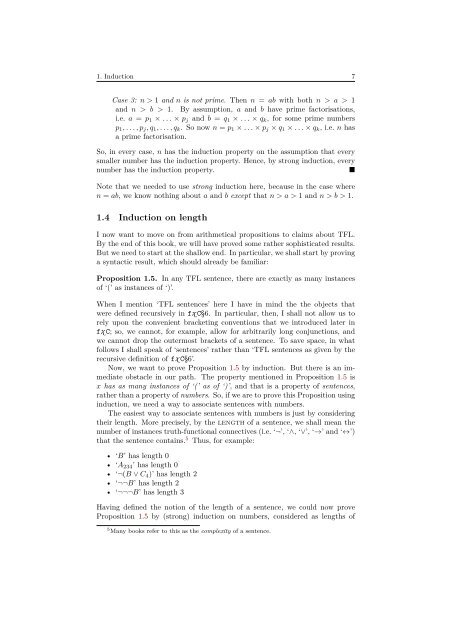Metatheory - University of Cambridge
Metatheory - University of Cambridge
Metatheory - University of Cambridge
Create successful ePaper yourself
Turn your PDF publications into a flip-book with our unique Google optimized e-Paper software.
1. Induction 7<br />
Case 3: n > 1 and n is not prime. Then n = ab with both n > a > 1<br />
and n > b > 1. By assumption, a and b have prime factorisations,<br />
i.e. a = p 1 × . . . × p j and b = q 1 × . . . × q k , for some prime numbers<br />
p 1 , . . . , p j , q 1 , . . . , q k . So now n = p 1 × . . . × p j × q 1 × . . . × q k , i.e. n has<br />
a prime factorisation.<br />
So, in every case, n has the induction property on the assumption that every<br />
smaller number has the induction property. Hence, by strong induction, every<br />
number has the induction property.<br />
■<br />
Note that we needed to use strong induction here, because in the case where<br />
n = ab, we know nothing about a and b except that n > a > 1 and n > b > 1.<br />
1.4 Induction on length<br />
I now want to move on from arithmetical propositions to claims about TFL.<br />
By the end <strong>of</strong> this book, we will have proved some rather sophisticated results.<br />
But we need to start at the shallow end. In particular, we shall start by proving<br />
a syntactic result, which should already be familiar:<br />
Proposition 1.5. In any TFL sentence, there are exactly as many instances<br />
<strong>of</strong> ‘(’ as instances <strong>of</strong> ‘)’.<br />
When I mention ‘TFL sentences’ here I have in mind the the objects that<br />
were defined recursively in fx C§6. In particular, then, I shall not allow us to<br />
rely upon the convenient bracketing conventions that we introduced later in<br />
fx C; so, we cannot, for example, allow for arbitrarily long conjunctions, and<br />
we cannot drop the outermost brackets <strong>of</strong> a sentence. To save space, in what<br />
follows I shall speak <strong>of</strong> ‘sentences’ rather than ‘TFL sentences as given by the<br />
recursive definition <strong>of</strong> fx C§6’.<br />
Now, we want to prove Proposition 1.5 by induction. But there is an immediate<br />
obstacle in our path. The property mentioned in Proposition 1.5 is<br />
x has as many instances <strong>of</strong> ‘(’ as <strong>of</strong> ‘)’, and that is a property <strong>of</strong> sentences,<br />
rather than a property <strong>of</strong> numbers. So, if we are to prove this Proposition using<br />
induction, we need a way to associate sentences with numbers.<br />
The easiest way to associate sentences with numbers is just by considering<br />
their length. More precisely, by the length <strong>of</strong> a sentence, we shall mean the<br />
number <strong>of</strong> instances truth-functional connectives (i.e. ‘¬’, ‘∧, ‘∨’, ‘→’ and ‘↔’)<br />
that the sentence contains. 5 Thus, for example:<br />
• ‘B’ has length 0<br />
• ‘A 234 ’ has length 0<br />
• ‘¬(B ∨ C 4 )’ has length 2<br />
• ‘¬¬B’ has length 2<br />
• ‘¬¬¬B’ has length 3<br />
Having defined the notion <strong>of</strong> the length <strong>of</strong> a sentence, we could now prove<br />
Proposition 1.5 by (strong) induction on numbers, considered as lengths <strong>of</strong><br />
5 Many books refer to this as the complexity <strong>of</strong> a sentence.
















